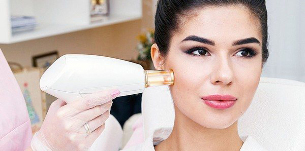
All women dream of preserving their beauty and youth as much as possible, using various methods. Modern medicine does not stop and is actively developing in the field of cosmetology, offering all types of procedures and operations to rejuvenate.
The techniques for hiding the obvious signs of aging without surgery and beauty injections are well known and sought after. Fractional laser rejuvenation in the modern world is considered one of the most effective methods to combat skin changes related to aging.
Fractional laser: what it is
When the laser is pointed at the skin, a burn occurs, which is deeper. Regenerative processes are activated, which contributes to obtaining the desired result. Also known as laser resurfacing.
In fractional technique, the beam is divided into several microbeams. The effect on the skin will be in the form of a mesh. After this exposure, the burns appear to be a large accumulation of microdots between the unaffected skin.
Important! This greatly reduces the damage to the skin, promoting its rapid healing.
Skin cells that have not been affected are actively dividing after laser treatment. In parallel, collagen and elastin are produced, which guarantee a youthful skin.
What is fractional photothermolysis and how does it work?
Fractional photothermolysisis a process of focal destruction of tissues by heating with light energy (laser).
The effect is due to two phenomena:
- First, the old tissue is physically destroyed and removed, where a new one grows, free of the defect;
- Secondly, due to the heating, the skin cells are activated, a phenomenon of the so-called "heat shock" occurs, when the cells begin to function as young cells, actively reconstructing the skin's collagen-elastin skeleton.
Ultimately, the skin is not only stretched and released from age spots, but also smoothed: scars and wrinkles are smoothed, stretch marks disappear, pores are reduced, it becomes more dense and elastic.
The visible effect is already noticeable after ONE procedure, and after several procedures, a pronounced rejuvenating result is observed. In addition, a good lifting effect is observed for several months after the procedure.
Types of procedure
There are two types.
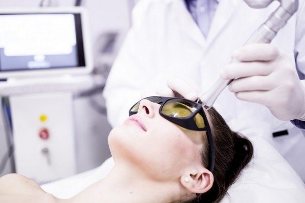
- Ablative. Laser exposure leads to tissue dehydration, resulting in the appearance of an open micro-wound and damaged cells around it. During the recovery process, a noticeable lifting effect is observed, but there is a risk of infection.
- Non-ablative. With this radiation, the skin remains intact, the water in the tissues does not evaporate and microscopic wounds do not appear. The process of the appearance and healing of burns occurs under the epidermis, which eliminates the risk of infection, however, the result of this rejuvenation will be less noticeable.
Important! A particular technique is selected by a specialist, taking into account the individual characteristics of the patient's skin.
Applied devices
The consequences depend not only on the skill of the doctor, but also on the type of equipment provided by the salon or clinic. In most cases, it is a European manufacturing technique. The sale is carried out in specialized stores or on the official websites of the manufacturers. For individual use, rental is possible.
Only professional equipment is used, it is very expensive. They aredifferent types: ablative and non-ablative (the work surface is pressed against the skin or held at a distance).
Problems that can be eliminated in this way
Post-acne. These scars are a very common problem that brings physical and emotional suffering. The procedure can reduce the appearance of acne scars. Depending on the type of scar, several skin resurfacing methods are used.
Wrinkles around the eyes. Expression wrinkles, dark circles are considered the main indication. It will not be possible to get rid of all wrinkles in one procedure, but their depth will decrease and they will be less visible. For a remarkable result, you will need 4-5 procedures.
Important! Dysport injections will help to deal with simulated wrinkles, which can also reduce the likelihood of new wrinkles appearing in the future.
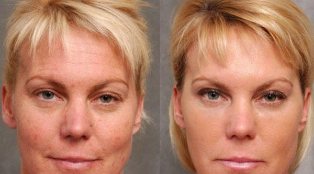
Wrinkles around the mouth. Considered the most serious type of wrinkle. To get rid of them, continuous laser grinding is applied. This method helps to reduce the length of the rehabilitation period, but requires more sessions (4-5).
Important! To obtain maximum results in a short time, you can combine the procedure with the injection of fillers.
What is the advantage of fractional photothermolysis on radio waves and photolifting?
Fractional photothermolysis, unlike laser resurfacing, removes the epidermis not immediately from the entire skin surface, but "fractionally" - in uniform micro-areas, each with fractions of a millimeter in size. At the same time, as there is no extensive wound surface and intact skin remains between the micro areas, healing occurs quickly and without negative consequences. The widely publicized photo and the raising of radio waves are based on heating the collagen fibers without removing the epidermis.
Merits
The main distinguishing feature of other procedures is the ideal balance between efficiency and safety.
Main benefits:
- the ability to influence any part of the body;
- extensive list of indications;
- the laser affects about 20% of the damaged area of the skin;
- fast recovery (3-6 days);
- accessibility of the procedure for black patients;
- long-lasting effect (more than 1 year).
Important! The only disadvantage is the insufficient disclosure of all the features of fractional laser rejuvenation, since the technology is relatively new.
Indications for use:
- wrinkles;
- insufficient skin elasticity;
- pigmentation;
- scars;
- enlarged pores;
- streaks.
Readings
Anyone who wants to rejuvenate without large appliances can use this method.
Fractional laser treatment combats many facial imperfections, including:
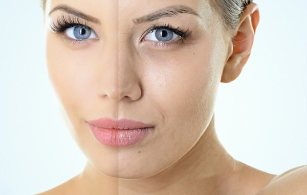
- severe wrinkles on the forehead;
- nasolabial folds;
- wire from crow's feet around the eyes;
- the epidermis "flowing down";
- skin pigmentation, scars, scars, spider veins;
- enlarged pore problem, acne.
Laser therapy has been shown to be highly effective in eliminating all of these problems.
The only caveat is that depending on the severity of the imperfection, several procedures may be necessary.
What is the method of facial electroporation and expert feedback on the effectiveness of the procedure. Read here for details on yellow peeling - what it is and what it is for.
Procedure
Before the procedure, the beautician may prescribe anti-infectious and antibacterial drugs for several days for prophylaxis.
Important! On the day of the procedure, you must completely stop physical exertion, drink alcohol and smoke.
Before fractional rejuvenation, the skin must be thoroughly cleaned and treated with special anesthetic agents. Sometimes this is not necessary.
Exposure to the laser can cause a slight tingling sensation. The duration of the procedure varies from 10 to 60 minutes. The number of sessions required is assigned to each patient individually. At the end of the exposure, a soothing cream should be applied.
Your skin needs special care in the future.
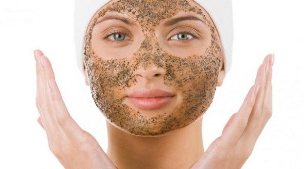
- Apply a moisturizer to the skin a few times a day for 10 to 14 days.
- Protect your skin from ultraviolet rays for 2 to 3 months.
- Do not use scrubs for 2-3 weeks.
- Abandon cosmetics containing retinol and salicylic acid for 2 weeks.
- During the recovery period, try to give up or limit yourself to bad habits.
Note!Typically, recovery takes 3 to 7 days.
Reviews and results
According to the assessments of most patients, non-ablative laser rejuvenation is actually very easy to tolerate and gives excellent results. After 3-6 sessions, which are held every 2-4 weeks, you can look younger for 5-10 years, while not taking long breaks at work and experiencing no serious inconveniences during the recovery period.
The technology allows you to preserve the top layer of the epidermis as much as possible.Partly, the protective properties of the skin are preserved and you can safely leave for 2-3 days, without forgetting theprotection against ultraviolet radiation. It successfully handles most of the first signs of aging. But to permanently remove mimetic wrinkles from the frontal region and nasolabial folds, it is advisable, after completing the rejuvenation course, to introduce Botox, which will not allow the muscles to contract and create new wrinkles on the skin. The lifting effect with proper facial care lasts up to 3-5 years.
Theme changes
After the procedure, redness, swelling and discomfort may occur for 2 days. If this condition is difficult to tolerate, pain relievers can be used to cool the disturbing area of the skin.
Over time, the skin may appear slightly tanned.
Important! Do nothing - normal skin color will return to itself after a few weeks. The skin will dry and peel over the course of a week.
Possible unpleasant consequences
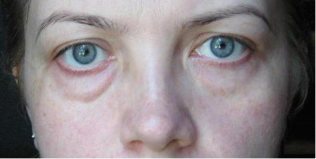
Don't worry if after the first procedure your skin turns red and "burns". This does not indicate the inaccuracy of the procedure, but it is considered a natural response by the body. After 2 to 3 hours, the swelling may also appear in the nose and eye area.
Important! To get rid of it faster, you must take care of the quick removal of fluids from the body (eat less salty and spicy foods, take a diuretic).
The next morning, many are horrified to see the blood on their skin. It can harden and form a crust. This is also considered a natural reaction. This type of procedure involves removing the upper protective layer of the skin - a new one appears under the crust. Therefore, it is strictly forbidden to touch with your hands and try to tear off the crust, otherwise there is a risk of infection, scars may appear on the face. The crust will peel on its own as soon as the tissue heals. This can be seen after 5-7 days, so be patient. After another month, the skin on your face will turn pink and will also be receptive to light - you will need to stock up on protective creams.
Adverse reactions after the procedure are no exception. Skin rashes, mild scabies and a different skin color may appear on certain areas of the face. In time, this will pass, but the sensations are quite unpleasant. High risk of side effects in patients with excessive skin sensitivity.
The cosmetologist prescribes care after individually fractionated thermolysis, but there are general recommendations. You need to wash your face only with clean, slightly warm (in no case hot) water. During the recovery period, forget about peeling and exfoliation. You cannot be in the sun for 7 to 10 days, after which it is worth using special creams. It is important to pay attention to adequate sleep, nutrition and rest. Following all instructions, after 2 weeks you can forget about the uncomfortable sensations.
Contraindications
To avoid unpleasant consequences, make sure that there are no contraindications.
Absolute contraindications include:
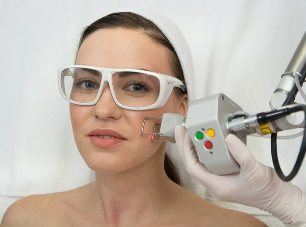
- pregnancy and lactation;
- tendency to scarring;
- chronic infectious diseases;
- oncology;
- serious immune system problems;
- worsening of psoriasis.
Among the relative ones are:
- high blood sugar;
- kidney disease;
- mental health problems;
- reluctance to follow an expert's recommendations;
- recent tan.
Important!Only beauticians with experience and the appropriate skills can be in charge of the procedure.
Preparation and execution
It is extremely important to find a highly qualified specialist to perform the procedure using non-ablative technology. Due to the delicate effect on the skin, there is simply no universal technique that would suit everyone. And we have to select an individual program for each patient, taking into account the age and condition of the skin.
Before the session
The preparatory phase can be very short. With the non-ablative method, there is no need to wait until the tan disappears. It also allows you to work on the skin with small, non-purulent pimples or acne (your condition improves markedly after the procedure). The most important thing is to make sure that there are no contraindications.
A few days before the first session, it is very important to avoid severe skin damage or irritation in problem areas. Therefore, it is better to abandon alcohol-based cosmetics and not peel.
You should also stop taking anticoagulants, tetracycline and retinol antibiotics. On the day of the session, it is best not to apply any cream on the face.
Technique
The procedure is very comfortable and takes 10 minutes to half an hour. The patient does not experience severe pain, so the use of local anesthesia is generally not necessary. But for people with a high sensitivity limit, it's allowed.
The procedure execution diagram looks like this:
- the patient fits comfortably on the sofa;
- the hair must be placed under a disposable hat;
- the face was completely cleaned of cosmetic remains;
- a cooling conductive gel is applied to problem areas;
- the head of the device is moved slowly over the skin;
- pressing the button generates a laser beam;
- after treating the entire surface, apply a mask with panthenol.
Within 15-20 minutes after the end of the session, you can safely go home.
Rehabilitation period
After laser treatment of the skin, a light crust forms. The time of its disappearance depends on the characteristics of the recovery process for a specific skin type. It also affects the rehabilitation period. Its duration is 2 to 4 weeks. In this case, it is not necessary for the patient to be constantly monitored by specialists, however, it is worth following all the prescribed recommendations for a month, namely:
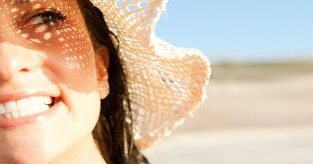
- give up physical activity;
- don't go to the solarium, baths, saunas;
- give up decorative cosmetics for a while;
- protect yourself from any mechanical stress.
Important! To achieve the desired result and maintain it for a long time, it is worth visiting a beautician periodically. It will not hurt to go through an entire course of procedures consisting of 4-5 sessions.
Method action
The laser beam penetrates the skin depth from a few microns to 3-4 mm. At the same time, its surface layer is not completely destroyed, although the natural protection is significantly weakened. As a result of such exposure, we obtain:
- reducing the depth of simulated wrinkles;
- almost complete elimination of small;
- noticeable tightening of the skin;
- restoring the sharpness of the face oval;
- fenders and double chin reduction;
- elimination of surface pigmentation;
- smoothing the skin relief;
- elimination of spider veins and mesh;
- narrowing of enlarged pores;
- improving skin tone;
- improves and evens the complexion.
Visually, after non-ablative rejuvenation, patients begin to look more invigorated. And after a well-conducted treatment course, you can "wipe" your face for 5 to 10 years. This leaves no wrinkles, scars and other traces of surgical operations.
Duration of the procedure
The duration is determined by the size of the area to be affected by the laser. The chin will take about 15 minutes, and the entire face, no more than 80 minutes. If laser cleaning or resurfacing of the top layer of the skin is necessary, it will take much less time compared to correcting the deeper layers.
Fractional CO2 laser
Fractional ray rejuvenation involves the use of precise techniques on the epidermis to correct age-related skin problems. The principle is the basis for most modern cosmetology devices. The fractional CO2 laser is popular and considered the most innovative development.
Important! The procedure is abbreviated as "fraxel".
Principle of action of fractional CO2 lasers
The basis of the laser operation is the mechanism of a dot effect, only the upper layers of the skin are heated and, between the "damaged" points, unharmed areas of the skin remain. Rejuvenation with the help of such a laser is in many ways superior to outdated methods, when the entire surface of the skin has been injured and the likelihood of contracting an infection, burning and other adverse reactions was several times greater.
The effectiveness of the technique is explained by the formation of microthermal areas in the tissues, which are the epicenter of the active processes of cell regeneration. Regeneration not only extends to these areas, it also affects healthy tissues.
Important! After partial rejuvenation, the skin regenerates much more quickly compared to the effect on the entire skin of the face, and the effect lasts for several years.
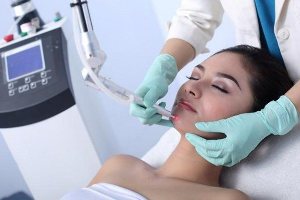
Fractional lasers are a relatively new development that already have specific stages of development.
Stage 1.Creation of an erbium laser, which is used in the non-ablative form of fractional laser rejuvenation. The superficial layer of the skin is not affected during its application, the effect occurs only in the deep layers. The procedure received many positive reviews from cosmetologists and patients.
Important! After a while, some deficiencies in the device were discovered, which made it necessary to improve it.
Stage 2. The advent of fractional CO2 laser. It differs from erbium because it works with mixtures of gases. During the operation of the device, microthermic columns appear that affect absolutely all layers of the skin. The cell division process begins around them, new ones appear. The advantages of this technology lie in the possibility of influencing even the most complex scars. In addition, using this method, you can deal with deep creases and porosity of the skin. Lasers also help to achieve a more noticeable result in skin rejuvenation, which is the main objective of this type of procedure. The device handles deep wrinkles, scars and pronounced skin defects without any problems. The laser beams are quickly absorbed by the water, which evaporates immediately.
Important! The device allows you to influence even areas such as cleavage, eyelids and neck.
Currently, most anti-aging drug manufacturers are developing similar lasers. In fact, each patient can purchase one or another type of device himself. When purchasing a fractional laser device, it is important to pay attention to its technical description and properties: energy density, size of the microthermal area, etc.
The fractional CO2 laser is distinguished by its ease of use due to its simple control, the ability to choose various geometric shapes and sizes of the illuminated area.
Important! Those planning to purchase such a device for rejuvenation must be convinced of the reliability of the manufacturer and suppliers, as lasers are quite complex from a technological point of view.










